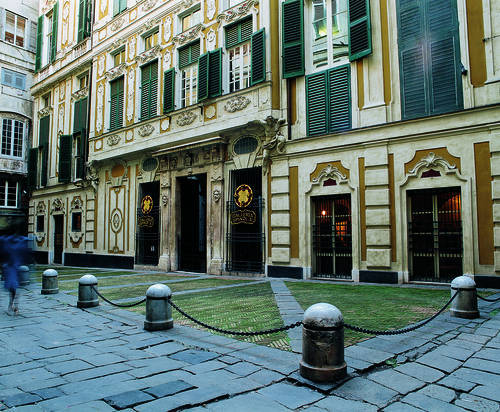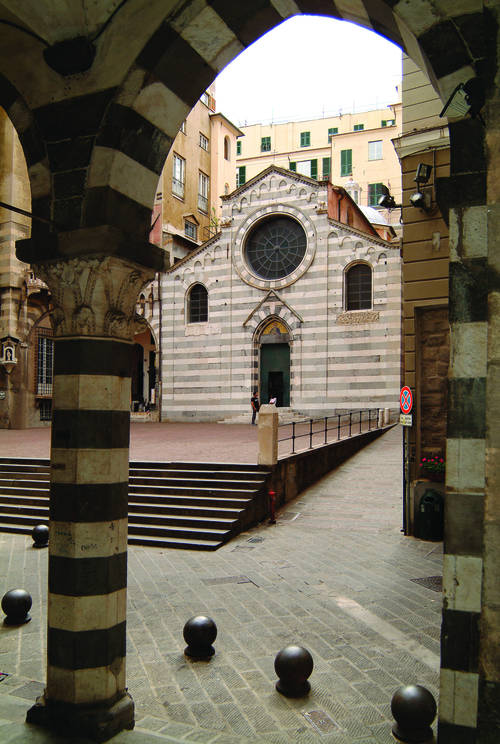Genoa city: an open-air museum

City view | © Landscape (Sagep archive – 2007)
One of the largest in Europe, Genoa’s historic centre unwinds in an intricate maze of alleyways (caruggi) that open unexpectedly onto small squares; the soul of the city lives here in these alleyways, where smells, tastes, and cultures have combined throughout history. In these narrow spaces, tucked away between the hills and the sea, the pride of wealthy Genoese merchants, indomitable leaders of the Republic, had beautiful mansions built, in which works of art have been collected and preserved for centuries and are visible to this day in several house-museums.
In this dense urban landscape, where the windows are so close they almost touch, architectural styles are layered over one another, with a medieval wall serving as the base of a 14th-century building and Gothic loggias becoming trendy bars: this is a place where the past forms the foundations of the present.
In the centre, where time seems to have stood still, noble palaces and splendid churches alternate with historic shops that have been in operation for over 100 years, where local specialities are still prepared according to ancient recipes and handmade objects are crafted with timeless skill.
At the corners, be sure to lift your gaze to admire the magnificent votive niches donated by ancient guilds to illuminate the streets at night.
The Tour sets off from the the Old Port area, and through Genoa’s narrow “caruggi” (alleyways), some of the main points of interest include the Cathedral, Palazzo Ducale the tour ends in “Strada Nuova” (Via Garibaldi), a UNESCO World Heritage Site. In the Strada Nuova Museums, Genoa’s main museum hub, which boasts a rich collection of masterpieces by Italian and foreign artists from the 15th to 19th centuries – with a significant number of works from the Genoese and Flemish schools – along with historical furnishings that once belonged to the Brignole-Sale family, Paganini’s violin, and the ceramics, coins, weights and measures of the old Republic of Genoa.
Unesco site – Palazzi dei Rolli
At the time when Genoa was a Republic, the ‘Rolli’ were lists of prominent stately homes belonging to noble Genoese families who were available, the honour of doing so being allotted by publicly drawing lots, to host distinguished guests travelling through Genoa on State visits. In 2006, 42 out of the over 150 Genoese palazzi became UNESCO World Heritage Sites. Some among the most beautiful Rolli buildings are in Via Garibaldi, once known as Strada Nuova, literally New Street. Palazzo Tursi is one of the grandest among the stately homes of Genoa.

Palazzo Spinola, part of UNESCO site “Palazzi dei Rolli” | © City of Genoa archive 2007
This square dates back to the early Middle Ages and is a prominent example of urban aristocratic settlement. It is lined with buildings whose façades are clad in distinctive black and white stripes. Along with its 14th century church and adjoining cloister, Piazza San Matteo once belonged to the powerful Doria family, who played a key role in the history of the Republic of Genoa. Andrea Doria was born in the palazzo on the corner and his remains rest in the crypt of the church.

San Matteo church | © City of Genoa archive 2007
Porta Soprana Gate and Christopher Columbus’ House
The Porta Soprana Gate is also known as Saint Andrew’s Gate from the nearby hilltop monastery knocked down in 1904. The Gate opens out into the so-called Barbarossa Walls, which date back to the 12th century and were meant to protect the freedom of the Republic from the Emperor’s expansionist aims. Not far from the Porta Soprana is the museumhouse of Christopher Columbus: this is an 18th-century reconstruction of the building where the discoverer of America lived, as the original was bombed by the French in 1684. A 12th-century cloister belonging to the ancient monastery of Saint Andrew stands next to Columbus’s house.
San Lorenzo Cathedral
Built between the 12th and 14th centuries, the Romanesque style, while the façade is Gothic. Through the centuries, the cathedral has undergone several changes that have altered the style of the interior. The largest of the side chapels is dedicated to Saint John the Baptist, patron saint of the city of Genoa. Dating back to 1465, this chapel is in the Renaissance style. The side chapels at the head of the aisles and the chancel date back to the 16th and 17th centuries. An unexploded bomb from the Second World War stands at the end of the right hand side aisle. The rooms which are adjacent to the Sacristy house the Museum of the Treasure of San Lorenzo, set up by Franco Albini in 1956. The museum houses relics and works of sacred art from the 12th to the 18th century.
Piazza Banchi
Close to the town’s most important harbor area, this square was first used as a farmers’ market. In the 12th century the area was taken over by merchants for the exchange of their goods and by the houses of patrician families. During the 13th century, the square was used by bankers, who conducted their currency exchange business out in the open. In order to supply them with a sheltered place to work in,
the Loggia dei Mercanti was built in the 16th century, according to designs by Andrea Ceresola, called Vannone. From 1855 onwards, the Loggia became the seat of the first Stock Exchange in Italy. The Church San Pietro in Banchi stands to the right of the Loggia and is a unique example of a place of worship placed above business premises. This peculiar mix of sacred and profane was the result of a compromise between the Lomellino family who wished to use the area for business purposes and the population of the district who needed to build a church in order to fulfil a vow.
DETAILS
07.30: departure by bus from Milan
10.00: arrival in Genoa and division into two groups
Group 1 – Genoa city: an open-air museum
Group 2 – Genoa: industrial archaeology and new architecture
12.00: Light Lunch at the Imperial Palace
14.00: Palazzo Tursi – welcome remarks and visit to the violin of Paganini
15.00 to 17.30: free time
17.30: departure